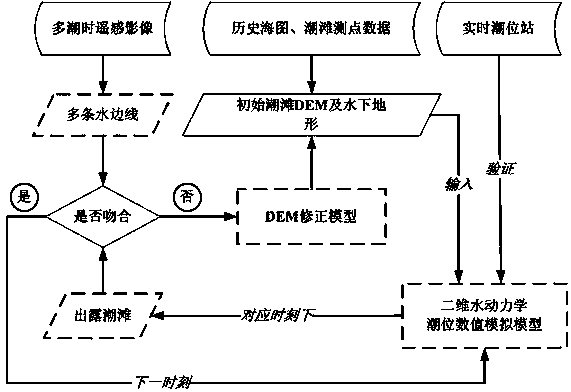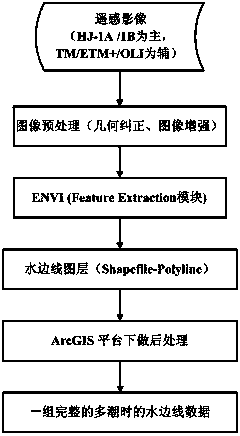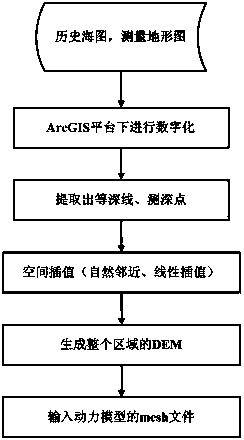Method for calibrating tidal flat DEM (digital elevation model) on basis of remote sensing water lines
A water edge and tidal flat technology, applied in special data processing applications, instruments, electrical digital data processing, etc., can solve problems such as uncontrollable accuracy, poor timeliness, difficult measurement, etc., to achieve simple and feasible technology, convenient operation, and solution acquisition difficult effect
- Summary
- Abstract
- Description
- Claims
- Application Information
AI Technical Summary
Problems solved by technology
Method used
Image
Examples
Embodiment Construction
[0033] Below in conjunction with accompanying drawing, technical scheme of the present invention is described in further detail:
[0034] A tidal flat DEM calibration method based on remote sensing water edge, such as figure 1 shown, including the following steps:
[0035] 1. Collect multi-source and multi-temporal remote sensing images of the tidal flat area, and extract the water edge, such as figure 2 As shown; the multi-source and multi-temporal remote sensing images are the remote sensing images of each tidal time with a spatial resolution of 30 meters within half a year, and are mainly based on the HJ-1A / 1B images of the environment and disaster monitoring and forecasting small satellite constellation, Landsat series satellites TM / ETM+ / OLI image as a supplement; after preprocessing the image for geometric correction and image enhancement, use the Feature Extraction module of the object-oriented space in ENVI to extract the water edge, and input the result into ArcGIS sof...
PUM
 Login to View More
Login to View More Abstract
Description
Claims
Application Information
 Login to View More
Login to View More - R&D
- Intellectual Property
- Life Sciences
- Materials
- Tech Scout
- Unparalleled Data Quality
- Higher Quality Content
- 60% Fewer Hallucinations
Browse by: Latest US Patents, China's latest patents, Technical Efficacy Thesaurus, Application Domain, Technology Topic, Popular Technical Reports.
© 2025 PatSnap. All rights reserved.Legal|Privacy policy|Modern Slavery Act Transparency Statement|Sitemap|About US| Contact US: help@patsnap.com



